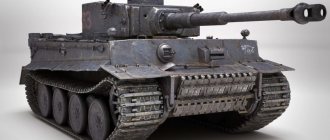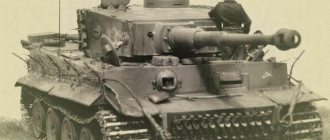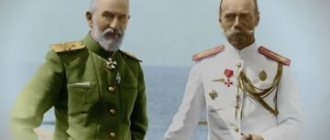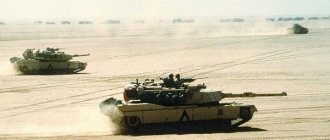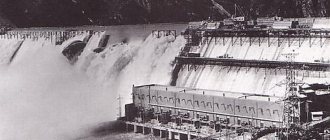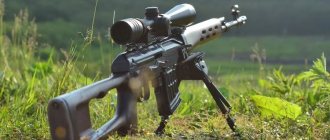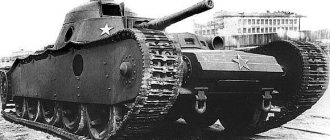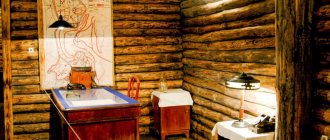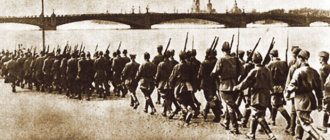The following types of armored vehicles were produced based on the Tiger:
- Tiger (P) - Porsche prototype (5 units);
- Befehlswagen Tiger I Ausf. E (Sd. Kfz. 267/268) - command tank;
- Sturmtiger ausf E - heavy self-propelled mortar (18 units);
- Bergenpanzer Tiger - heavy recovery vehicle (3 units);
- Ferdinand/Elefant - heavy anti-tank self-propelled gun, chassis from the Porsche Tiger (90 units).
"Tiger" of the early series of the 503rd battalion.
Russia, 1943. Taking into account the street fighting in Stalingrad on August 5, 1943, it was decided to create an assault self-propelled gun based on the Tiger, armed with a 380-mm ship-borne mortar (firing range - 4600 m). The new self-propelled gun was given the name 38cm RW61 auf Sturmmurser “Tiger” or simply “Sturmtiger”. A total of 18 vehicles were produced, all of which entered service with the 1001st, 1002nd, and 1003rd assault mortar companies. They were first used to suppress the Jewish uprising in the Warsaw ghetto. Mainly used in the defense of German territory.
In 1944, three vehicles were converted into Bergenpanzer Tiger restoration vehicles. Instead of a turret, a winch was installed on the hull. All vehicles fought in Italy (Anzio).
In 1945, it was planned to convert a number of Tigers into flamethrower tanks. On Flammtiger vehicles, the flamethrower was installed instead of the 7.92 mm MG.34 machine gun.
Real fight
It would seem that, based on the totality of characteristics on paper, plus or minus, a draw with a slight advantage is on the side of the “Tigers”. But everything is broken by one nuance: meeting each other is not even five or ten percent in the life of heavy tanks. There are about a dozen documented clashes between Tigers and IS-2s throughout the war - which, by war standards, is even less than a grain of sand in the sea. The vast majority of both the “Tigers” and the ISs did not even see each other in battle!
This means that it is necessary to compare tanks in terms of their suitability for combined arms combat - after all, “pure” tank duels without the influence of other branches of the military are extremely rare.
Tigers in the Alps (www.tiif.de)
Tigers in the Alps (www.tiif.de)
First, let's turn to the "Tiger" - it was released in commercial quantities onto the battlefields in 1943, it was needed as a weapon for a large offensive. It required a combination of two things - strong armor capable of withstanding fire from anti-tank guns, and a powerful weapon. The Tiger had the first. The second, it would seem, too, but only for that very year 1943.
When the Russian tank went into production the following year, the championship in armament was lost. The 122-mm IS-2 projectile had a much greater high-explosive effect and radius of scattering fragments. The Soviet tank was simply ideal for attacking and direct fire - it was easier to destroy anti-tank guns or firing points that hindered the advance of one's own infantry.
IS-2 in East Prussia, 1945 (waralbum.ru) |
IS-2 near Berlin, 1945 (berlin70.aif.ru) |
First fight between IS-2 and “Royal Tiger” (7 photos)
Author: Evgeny
12 September 2022 22:46
Community: Military
Tags: USSR military history nostalgia facts
17485
7
IS-2 is considered one of the most famous heavy tanks of World War II; it could successfully fight not only with Tigers and Panthers, but also with such a giant as the Royal Tiger...
By August 10, 1944, the troops of the 1st Ukrainian Front, having crossed the river. Vistula, broke through the enemy defenses southwest of the Polish city of Sandomierz and, having overthrown units of the enemy's 4th Tank Army, significantly expanded the bridgehead. In an effort to restore lost positions along the western bank of the river. Vistula, the Germans urgently transferred five divisions (including one tank) from Army Group Southern Ukraine, five infantry divisions from Germany, three infantry divisions from Hungary and six brigades of assault guns to the Sandomierz area. In preparation for the German counter-offensive, the Soviet command regrouped its troops. Defensive fortifications were urgently erected and mine-explosive barriers were installed.
0
See all photos in the gallery
×
On August 11, having deliberately retreated from the previously taken town of Szydłów and the village of Oglendów, parts of the 6th Guards Tank Corps of the 3rd Guards Tank Army also went on the defensive. The bridgehead by this time was an uneven road abutting the river. The Vistula semi-circle, in the center of which the 53rd Guards Tank Brigade occupied the defense, with the 52nd GvtBr adjoining its left flank. It was not possible to dig full-profile shelters for vehicles in sandy soils - the walls of the trenches immediately crumbled. This area also caused a lot of trouble for the Germans. Our tank crews repeatedly observed how Panthers often skidded in the sand and how their driver-mechanics, when trying to get out, had to expose the weak side armor of their vehicles to the fire of our troops. In previous battles for Szydłów and Oglendów, these Panther maneuvers helped inflict serious losses on the enemy (on August 11, 1944 alone, tank crews of the 53rd GvtBr destroyed 8 enemy tanks). Therefore, on August 12, the commander of the 53rd GvtBr, Colonel V.S. Arkhipov, with his chief of staff S.I. Kirilkin, came to the conclusion that the enemy would no longer cross the open sandy fields, but would try to bypass the brigade’s positions from the flanks, so they were standing on them concentrate all your attention. In front of the 2nd tank battalion of Major A.G. Korobov, the entire terrain was in full view. On the right flank, where T-34 tanks of the 3rd TB captain I.M. Mazurin occupied the defense, there was a deep and wide ravine along which a field road ran from the village of Oglendow to the town of Staszow to the rear of our troops. Behind the ravine there was a swamp, where the 294th Infantry Regiment of the 97th Infantry Division went on the defensive.
0
The road stretching in the lowlands, leading directly to the target, could not go unnoticed by the Germans. To cover this path, the brigade command decided to ambush two T-34 tanks from the 3rd TB at the exit from the ravine on the slopes of an unnamed height, entrusting their command to the deputy commander of the guard battalion, Captain P. T. Ivushkin. The remaining tanks of the battalion were located in the main defensive positions a kilometer from Oglendów.
0
Initial assumptions about the enemy’s plans were confirmed already in the first reconnaissance reports, which were carried out by patrols and three armored groups on tanks and motorcycles in the expected directions of the enemy’s advance. In intelligence report No. 53 of the headquarters of the 6th GvTK, compiled at 19.00 on August 13, it was reported: “On the night of 12 to 13.08, in the area west of Szydłów, prisoners were captured of a sergeant major belonging to the 1st company of the 501st separate battalion of heavy tanks of the RGK, and a private, belonging to the 10th company of the 79th MP of the 16th TD, taken in the Ponik area. The sergeant major testified that at Koneupol station, after the 501st separate battalion of heavy tanks of the RGK had unloaded, a tank division of a number unknown to him was unloaded. The 501st TB consists of three TRs and a supply company. The battalion arrived with 40 tanks, 20 of them Panther type and 20 T-IV. Up to 30 tanks arrived in Khmilnik, the rest are out of order and require easy repairs.” The arrival of the 501st separate heavy tank battalion under the command of Major von Legat spoke volumes in itself. In July - August 1944, the battalion was reorganized at the training center in Ohrdruf and received a new material unit - the pride of German tank designers, which were previously called "all-destroying" - Tiger-B tanks. However, the low reliability of the “raw” vehicle (which began to be developed back in 1942, but was never brought to fruition) led to the fact that the battalion was sent to the Eastern Front on August 5th incompletely, since 14 tanks with various problems were concentrated in the 1st company, which remained in the training center. On August 9, the battalion arrived in Poland and unloaded at the Konsupol station near the city of Kielce. As the prisoners showed, of the 40 tanks, only half were heavy Panther tanks, the rest were supplemented at the last moment with Pz Kpfw IVs. It later turned out that the prisoners' words about the arrival of the Panthers were untrue. Most likely, the prisoners tried to hide from the enemy the appearance of a secret new product at the front, since these “Panthers” turned out to be the newest “Royal Tigers”. During the short march from the unloading station to the headquarters of the 16th TD, located in the Khmelnik region, 10 faulty tanks remained along the three kilometers of the route. Having spent a couple of days repairing and preparing equipment, the battalion on August 11 made a 2-km march and reached the town of Szydłów. Since the march was again accompanied by breakdowns of new vehicles, by the end of the day the battalion had only 11 serviceable Tiger-B tanks in service - which had to receive a baptism of fire in the attack on Staszow.
0
Tankers of the 53rd Gvtbr inspect the "Royal Tiger" they shot down.
It should be noted here that the forces of the 6th GvTK did not at all provide the Soviet tankers with significant numerical superiority: the Germans were opposed by nine combat-ready T-34-76 from the 53rd GvTBr, nine T-34-76 and ten T-34-85 from the 52nd GvTbr, and the 51st GvTBr, which occupied the defense (in the north), had eleven T-34–76 tanks and four T-34–85 tanks. Staszow also had eleven IS-2 heavy tanks and one IS-85 tank, belonging to the 71st OGvTTP. From the middle of the night from August 12 to 13, the growing rumble of tank engines in the depths of German positions could be heard more and more clearly. Before dawn, the commander of the 53rd Gvtbr returned from headquarters to his tank, which served as an observation post and was in the battle formations of the 1st TB, whose vehicles were hidden by a ridge of low sand dunes. Ahead on the right stretched a ravine with a road leading to Staszów. On the left, heaps of straw were scattered on the field, in which Ivushkin’s tanks were camouflaged. Closer to the exit from the ravine stood the “thirty-four” of junior lieutenant A.P. Oskin, whose crew included: driver A. Stetsenko, gun commander A. Merkhaidarov, radio operator A. Grushin and loader A. Khalychev. Colonel Arkhipov and Ivushkin approached the haystack hiding the tank on their bellies, and, after talking with Oskin, they ordered not to open fire without a command. The morning turned out to be foggy. From the observation post of the commander of the 53rd brigade, neither the outskirts of the village of Oglenduwa, nor the ravine, nor even the piles of straw with camouflaged tanks were visible. The silence of the early morning was interrupted by the slowly increasing rumble of tank engines, and soon the approaching clank of caterpillar tracks could be heard. From the air came the roar of the Junkers heading towards Staszow. Then the German artillery opened fire, but the shells swept high above the brigade's front line. Enemy reconnaissance was never able to detect the battle formations of the 53rd Tank Brigade, not to mention the ambush. At 7.00 on August 13, the enemy, under the cover of fog, launched an offensive on an unnamed height with eleven Tiger-B tanks, accompanied by several armored personnel carriers with infantry. Ivushkin reported to the OP: “The tanks have arrived. I don't see, but I hear. They are walking through the ravine." Here is how the further course of events was described by the commander of the 53rd Gvtbr:
0
Royal Tiger No. 502, abandoned by its crew on the outskirts of Oglendow.
“A tank of monstrous size was emerging from the ravine. He crawled up the hill in jerks, skidding in the sand. Major Korobov radioed from the left flank: “They’re coming.”
0
Royal Tiger No. 234, stranded and abandoned by its crew on the outskirts of the village of Oglendow
I answer: “Don’t rush!” Hit from four hundred meters. Meanwhile, a second giant crawled out of the hollow, then a third appeared. They appeared at significant intervals: by the time the third tank emerged from the ravine, the first had already passed Ivushkin’s ambush. "Beat?" - he asked. “Hit!” I see the side of the haystack where Oskin’s tank stands moving slightly. The sheaf rolled down and the cannon barrel became visible. He jerked, then again and again. It was Oskin who fired. I clearly saw through binoculars how black holes appeared in the right sides of the enemy tanks. So the smoke appeared and the flame flared up. The third tank turned to face Oskin, but after riding on a broken track, it stopped and was finished off. I broadcast on the radio: “307 - 305.” The signal is general. Direct fire hit about three dozen guns at once. And howitzer battalions covered the ravine with canopy fire, and it disappeared all the way to Oglendów in clouds of smoke and sandy dust.” Junkers and Messerschmitts appeared, and almost simultaneously our fighters. The battle began in the air. During the day, Korobov's 2nd tank battalion fought with enemy tanks west of Hill 247.9. By the end of the day, the 53rd Brigade took up defensive positions along its southern part - 300 m east of the village of Oglendów, in readiness for an attack in the direction of Shedłów. Two tanks of the 3rd TB with a company of machine gunners attacked the village at 22.00, which was completely cleared of the enemy by eight o’clock in the morning. After which the 3rd TB gained a foothold on the outskirts. Among the trophies taken in the village were German tanks that had retreated after an unsuccessful attack. It was here that it turned out that the battle had to be fought with the latest German tanks (on a foggy morning there was no time to sort it out, and in the first reports, having counted the burning tanks, they reported the destruction of three Panthers). The 2nd TB, in cooperation with the 2nd tank company of the 71st OGvTTP and the 289th rifle regiment, began an offensive in the direction of Zarez at 9.00. The Tiger-Bs, located west of Oglendow, blocked the path of the advancing infantry with their fire. Then a platoon of IS-2 tanks, guard senior lieutenant Klimenkov, moved forward and from pre-prepared positions opened fire on enemy tanks; as a result of a short battle, Klimenkov burned one tank and knocked out one. After this, the infantry, without encountering strong resistance, entered Oglendów, where the tanks of the 3rd TB were already finishing off the enemy. At this time, 7 Tiger-B tanks attacked our positions from the direction of height 272.1. Being in an ambush in the bushes east of Mokre on an IS-2 tank, Guards Artillery Lieutenant Udalov (Udalov fought on an IS-2 with turret No. 98, which had a D-25 cannon) allowed the enemy tanks to reach 700 - 800 m and opened fire in the head and after several well-aimed shots, one tank was burned and the second was knocked out. The enemy tanks turned away and began to retreat. Udalov drove his car along a forest road towards the enemy and opened fire again from the edge of the forest. Leaving another burning tank, the enemy turned back. Soon the attack of the “Royal Tigers” was repeated, this time they were moving in the direction of Ponik, where the IS-2 tank of Guards Lieutenant Belyakov was lying in ambush, who opened fire from a distance of 1000 m and set the tank on fire with a third shell. Seeing here a direction that was disastrous for the offensive, the remaining enemy tanks turned back. In total, during three days of continuous fighting from August 11 to 13, 1944, in the area of the towns of Staszow and Szydłów, troops of the 6th GvTK captured and destroyed 24 enemy tanks, 13 of which were the latest heavy Tiger-B tanks. “In the period from August 9 to 19, 1944, the 52nd GvTBr captured 7 and destroyed 225 soldiers and officers, destroyed one machine gun, captured 3 cannons, destroyed 6 tanks and 10 trucks, two special vehicles.” In addition, as follows from the reports of units and formations of the corps about prisoners and trophies captured from the enemy: In total, from August 1 to August 29, 1944, the 53rd Tank Brigade destroyed 8 chief officers, 37 non-commissioned officers, 153 soldiers, captured 2 non-commissioned officer, 6 “Royal Tigers” and destroyed: 1 aircraft, 12 tanks, 29 howitzers, 150 rifles, 7 machine guns, 20 machine guns, 4 mortars and 2 cannons.” It should be noted that this success was all the more impressive because the units of the 6th GvTK did not lose a single tank in these battles. The enemy’s losses, a little later, were confirmed by reconnaissance report No. 39 of the headquarters of the 6th GvTK, compiled on August 16 at 19.00: “On August 16, in the Zaraz area, a prisoner belonging to the 501st battalion of heavy tanks was captured. The prisoner testified that the 501st separate battalion of heavy tanks was formed in Germany and received 40 new tanks: up to 20 “Royal Tigers” and up to 20 “T-4” types. The battalion arrived in the Khmilnik area two weeks ago. Currently, the battalion has up to 26 tanks left, the rest have been burned and destroyed. The prisoner, in addition to his tanks, saw Tiger tanks from another unit. The prisoner does not know the unit number.” According to the memoirs of the commander of the 53rd Gvtbr: “... who knocked out and how many is a difficult question, since the tankers of two battalions - I.M. Mazurin and A.G. Korobov, and two artillery units attached to us (185th howitzer and 1645th light) two self-propelled artillery regiments (1893rd and 385th). The attack aircraft worked well. Oskin's crew burned three tanks and knocked out one. Alexander Petrovich himself was awarded the title Hero of the Soviet Union, Abubakir Merkhaidarov - the Order of Lenin. All crew members received awards.”
0
Royal Tiger #502.
After the battle, the commander of the 2nd TB Korobov compiled a report in which he indicated that “about 20 large tanks were advancing at the junction of his battalion and the 51st Guards Tank Brigade.” The question is legitimate: where did the rest of the “Royal Tigers” go? They were also unlucky. They were ambushed by the command of the 52nd GvTBr, which was occupying the defense on the left flank of the 6th GvTK. On August 12, the 2nd tank battalion of this brigade, under the command of Major A.N. Golomidov, was located at the edge of the forest near the village of Mokre, located a few kilometers west of Staszow. Towards evening, the battalion commander called the company commander, Senior Lieutenant V.I. Tokarev, and, indicating a point on the map, ordered an ambush there. A kilometer from the battalion’s battle formations, in the area of a high-rise with bushes, two tanks, led by a company commander, were ambushed. The tank crews spent the entire night of August 13 without sleep. "Thirty-fours" were partially dug into the ground among piles of sheaves of bread. It was completely impossible to detect both cars. This is how the further course of events was described by the commander of the 52nd Guards Tank Brigade, Hero of the Soviet Union Guard, Lieutenant Colonel L.I. Kurist: “Early in the morning, the so-called “frame” appeared in the sky - an enemy spotter plane. He flew over our area and disappeared. A little later the enemy opened strong artillery fire. The shells whistled over the heads of the tankers and exploded behind them - at the edge of the forest and the outskirts of the nearby village. “Now the Tigers and Panthers will come,” Tokarev said when the raid stopped. “I’ll be in the trench, I can see better from there.” And you, Georgy (Komarichev - senior sergeant, gunner of the company commander's tank), be on your guard. Komarichev and Dzhoparidze (the loader) intensely peered into the distance, from where the roar of engines could be heard. A few minutes later, they saw armored vehicles appear from behind the hill, coming from the ravine, bypassing the height, exposing the sides to our tanks. Apparently, the Germans did not even imagine that there could be an ambush here. “Five, six, seven... twelve...” Komarichev counted. - Tengiz! Twenty! You see, twenty!!! And behind them - infantry! - Nothing, Zhora. We are the guards! - Let's get armor-piercing! The crew of junior lieutenant Stepan Krailov also noticed the enemy tanks. The tankers decided to let the enemy get close enough to hit for sure. When the Germans were about five hundred meters away, Komarichev and Krainev opened fire. Komarichev’s shot set one Tiger on fire, Krainev knocked out another. The Nazis made desperate attempts to break through to the edge of the forest. The tanks took a little to the left. However, this did not help either: burning and damaged vehicles remained on the battlefield. Having suffered heavy losses, the Germans wavered, the tanks turned around and began to gradually retreat back. They refused further attempts to advance on the line occupied by the brigade.” The intensity of that battle can be judged if only because the tank crews used up almost all the shells. Komarichev and Japaridze accounted for eight destroyed Tigers and Panthers. Krainev knocked out six: “...Having entered into confrontation with the enemy, our tankers destroyed 14 tanks, more than 50 Nazis, and most importantly, thwarted the enemy’s counterattack in their sector.” Unfortunately, both tank brigade commanders did not separately indicate in their memoirs the exact number of destroyed and knocked out Royal Tigers. According to the latest data published in the book “Tactics of the Tiger-I and Tiger-II tanks” by the English researcher Thomas Jentz, a week after the battle on August 21, 1944, the 501st Tank Battalion had 12 serviceable Tiger-II tanks, 27 tanks required repairs, and six Tiger-II tanks were irretrievably lost. However, in citing these data, the author is somewhat disingenuous. There were 12 Tiger-B tanks left on the battlefield at Ogledów, Mokre and Szydłów. Today, from archival data it is clear that during these battles it was possible to completely defeat the 501st separate battalion "Tigers-B", while capturing three completely serviceable vehicles of a new model, with turret numbers 102, 502 and 234. Tank No. 502 was found standing in the courtyard of a house on the outskirts of the village of Oglendów. The reason why the crew abandoned a technically sound combat vehicle remains unclear. Most likely, since the village of Oglendow was taken with one swift rush of our tanks, the crew of the “Royal Tiger” simply fled in panic, leaving all the technical documentation inside the vehicle. The tank had full ammunition and a sufficient supply of fuel. According to the technical documentation found in it, it turned out that the tank traveled only 444 km. When I tried to start the engine, it started “half a turn”. The captured tanks No. 102 and No. 502 were command tanks, as they had additional means of communication. The Germans appreciated what happened with dignity, removing von Legat from his post within a week. Soon, an editorial appeared in the front-line newspaper of the 6th GvTK “Battle Call” with the subtitle - “The best tanks in the world are ours, Soviet!” It highlighted the recent events on the Sandomierz bridgehead: “...Seeing our tanks, which were superior in everything, the Germans began to build their clumsy and clumsy monsters - “Tigers”, “Panthers” and “Ferdinands”. But these cars were still inferior and inferior in quality to Soviet cars. This has been proven from recent battles, where the retreat route of the German armies is strewn with the wreckage of Tigers and other German equipment. The last German tanks of the T-VIB type “Royal Tiger” did not frighten the Soviet soldiers either. At the very first meeting with them, our tankers and artillerymen proved the absolute superiority of our combat vehicles against this so-called “secret” weapon of the Germans. Our valiant tankers Oskin, Udalov and Potekha destroyed several “Royal Tigers” in the very first battle... The experience of fighting on the Soviet-German front proved that the advantage of Soviet tanks over German ones is clear and undeniable. Our new tanks have the best gun, they have high cross-country ability and maneuverability.” Thus, the first step was taken towards the creation of a legend that obscured with its vulgar and clumsy propaganda the actual and much more impressive success of our tank warriors. The reasons for the complete fiasco of the “Royal Tigers”, which never met the hopes of the Germans at Sandomierz, were the skillful organization of defense and, undoubtedly, the skill of our tankers. On the other hand, the enemy was let down by numerous miscalculations in planning and tactics, and an unsuccessful choice of direction for the use of heavy tanks, especially the 70-ton Royal Tigers. The desire to quickly throw an unfinished “miracle weapon” into battle ultimately led to the fact that the next “pancake” prepared by the German “tank cooks” never made it to the table in proper form. By the way, for some reason some Western sources claim that the allegedly captured Tiger with number 502 actually had number 002, and that the Russians themselves allegedly changed the number. This stupidity is hard to believe. Firstly, it makes no difference what number the tank has and, therefore, there is no point in changing the numbers. And secondly, according to German reports, it is easy to check which tank numbers were part of the 501st battalion. And then it turns out that the Royal Tiger number 002 never existed. But there was a tank with number 502. To complete the picture, I would like to note that the 501st heavy tank battalion (s.Pz.Abt.501) was formed on May 10, 1942 from two tank companies. He was part of the 7th Tank Regiment. On March 6, 1943, the third company was included in the battalion. Participated in battles in North Africa, where in May 1943 it was almost completely destroyed. Recreated on September 9, 1943. In the summer of 1944, having received new equipment (Royal Tigers), the battalion was included in the Northern Ukraine Army Group and sent to the Eastern Front. After the events described at Staszow, the battalion fought defensive battles near the Pilica River, again suffered heavy losses and by the fall was withdrawn to the rear for reorganization. In the fall, on November 27, 1944, the battalion was renamed the 424th heavy tank battalion and assigned to the XXIV Panzer Corps, and the former 101st SS heavy tank battalion was then renamed the 501st. Posted by Anton at 11:12
Source:
More cool stories!
- When a date didn't go according to plan: stories from the Internet
- An 11-year-old man was bedridden and cured himself
- Magnificent seven facts about everything in the world
- The job of a car mechanic is full of surprises.
- Finds from the La Pomoika boutique
subscribe to the "Military" community
Tags: USSR military history nostalgia facts
Do you like to remember how things were before? Join us, let's feel nostalgic together:
270 10 260
Liked
260 1
32
Partner news
The Tigers burned like matches.
This is a complete lie. Despite the forward location of the transmission, not a single Tiger was set on fire by a shot in the forehead. If only because in 1942-1943 not a single enemy tank was capable of penetrating the Tiger in the frontal projection even from 200 meters. But will the Tiger, capable of hitting any armored enemy targets of that time from a distance of 2,500 meters, be allowed to approach such a distance? From a distance of 800 meters, an 88-mm Tiger shell pierced the frontal armor of a T-34 or Sherman, rushed through all compartments, killing several crew members along the way, pierced the engine, rear armor plate, flew out of the tank and flew on... echoes of anti-aircraft past KwK36 L/56. With the advent of the T-34-85, the problem of fighting the Tigers was only partially solved. Arrangement in a diamond shape made it possible to artificially simulate the inclination of armor plates, which improved projectile resistance, although now Soviet tanks could count on success from 500-600 meters. The T-34-85 was hit just as easily as the T-34. Large-caliber guns of the end of the war (122-mm D-25, 152-mm ML-20), with a successful hit, the explosion simply tore off the Tiger’s turret, preventing it from even catching fire.
Myths of pseudo-specialists and fanatics.
Strength and power have always made you fear, respect and admire yourself.
Especially weapons. Legends were made about his invincibility. The same thing happened with tanks. However, fear has big eyes, and opponents, as a rule, notice only each other's strengths. The weaknesses of using weapons become known only in battle. And only to those who control it. Also, statements about the complete superiority of a particular machine should not be taken as truth. These opinions are initially subjective, if only because each of the tanks was created with the aim of performing strictly defined tasks in battle and, accordingly, had a strictly defined set of qualities that would allow it to do this. Based on this, you need to understand which qualities were of a primary nature and which were secondary. In the end, wars are won not by technology, but by people. It is the correct assessment of the combat situation, terrain, determination of tactics and tasks for the entire group of troops and for each combat unit separately based on its purpose that lead to the final success of the operation. Therefore, a correctly used combat unit will always pose the maximum danger. If used uncharacteristically, the combat unit will not be able to reveal its full combat potential and will become an easy target for the enemy. Now let's look at some rather bold statements by pseudo-experts.
"Tigers"/ISs were destroyed in the hundreds.
A lot of evidence about the destruction of the Tigers is motivated by the fact that there were many ordinary people in the Soviet army and few were able to correctly identify the tank. Thus, almost every destroyed German tank turned out to be a “Tiger”, and a self-propelled gun turned out to be a “Ferdinand”. The same PzIV looked from afar like the Tiger, and the Hummel and Nashorn looked like the Ferdinand. The same should be said about the German side - although the German army had more trained soldiers, it was still difficult to accurately identify the enemy tank in the heat of battle and at a great distance. After all, they tried to camouflage that T-34-85 by installing a muzzle brake so that from afar it would resemble the IS-2. Plus, the propaganda of both sides also did its job, trumpeting about hundreds of destroyed enemy tanks with just one formation of its own. Although, if we sum up all this evidence, then in the end there will be several times more of them than the tanks themselves were produced. Another important aspect is the division between tanks that were irretrievably lost and those that were repaired and went into battle again. All this means that there can be no talk of several dozen tanks on one account. This applies to both sides. However, even according to the most conservative data, the ratio of irretrievable losses on the German and Soviet sides was equal to 1:5. As you know, a necessary requirement for successful defense is that there should be no more than 4 attackers per defender. As we can see, even according to the most conservative data, the German side showed the best result, however, there were many more attacking Soviet forces. Having destroyed some of them from long distances, the Tigers lost their main advantages in firepower and armor and began to suffer in close combat from their shortcomings - clumsiness compared to medium tanks.

